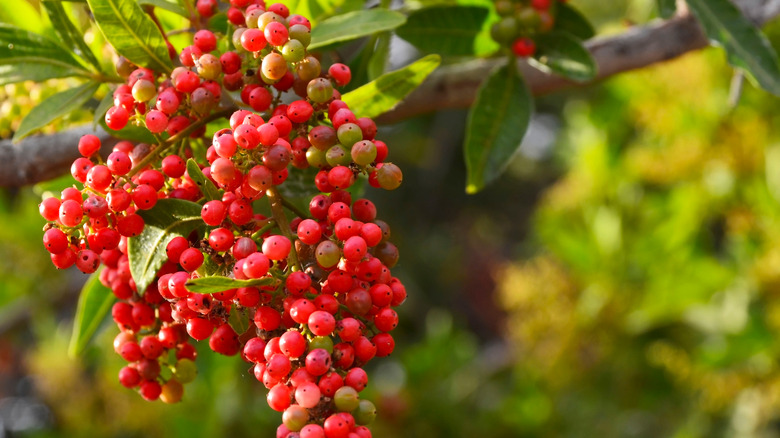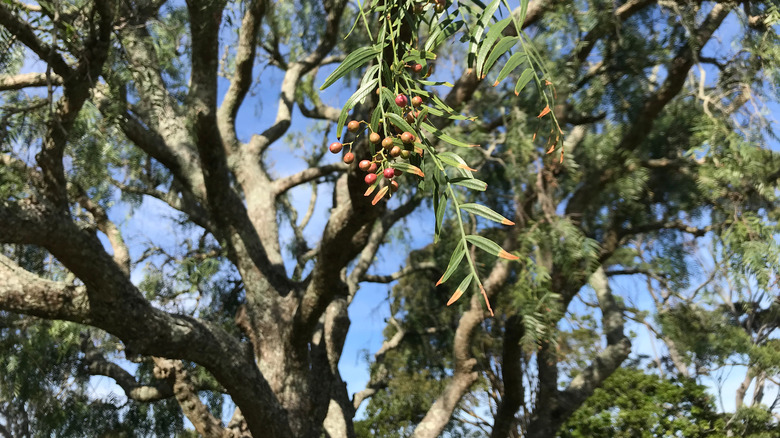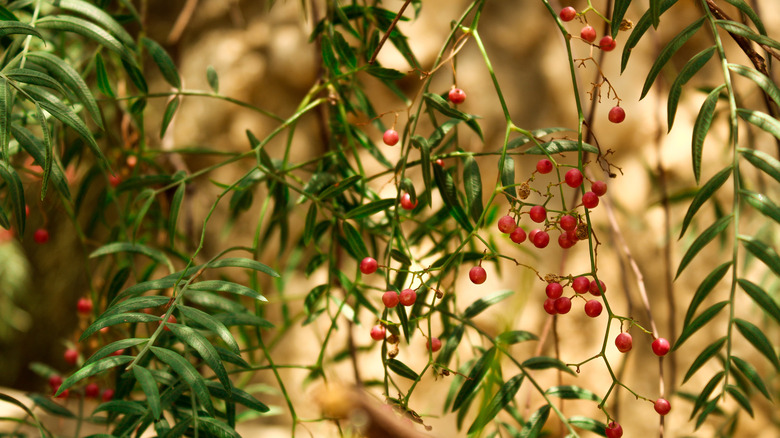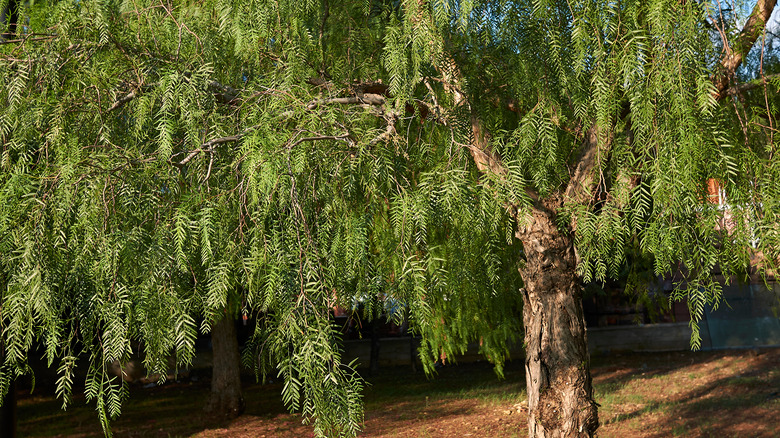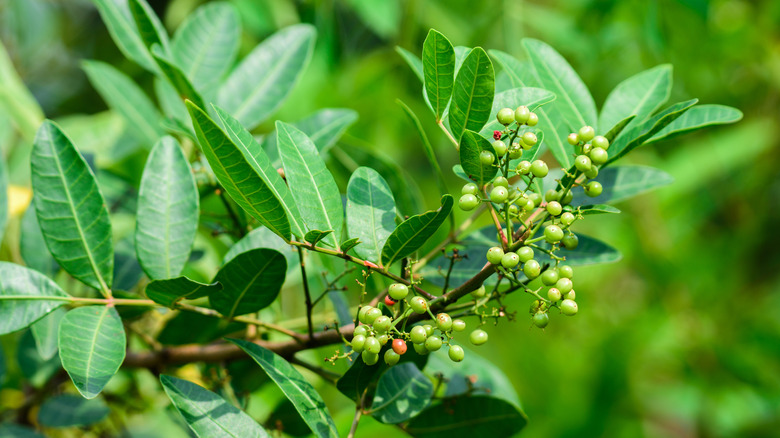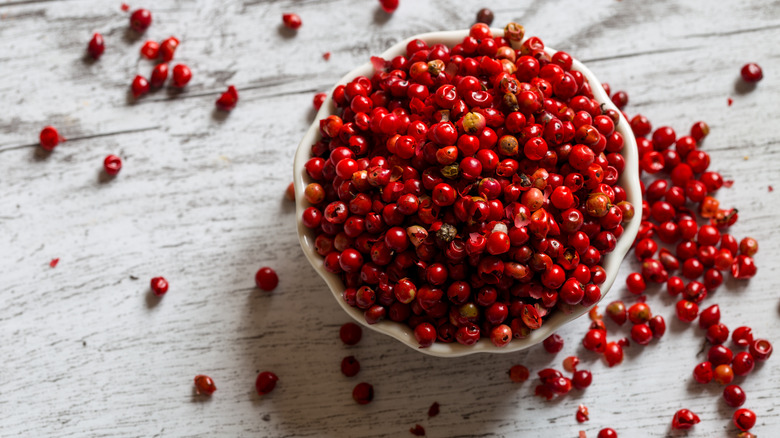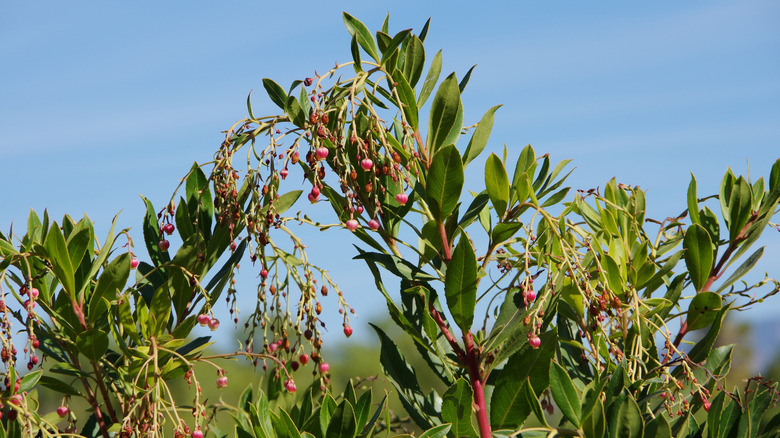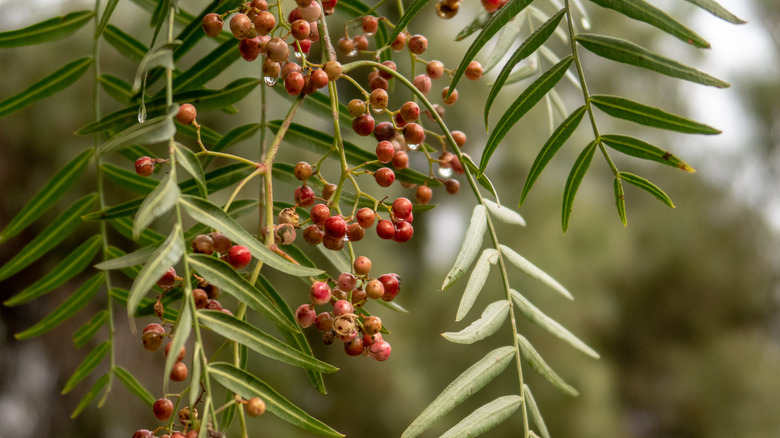How To Grow And Take Care Of A California Pepper Tree
The Schinus molle, more commonly known as the California pepper tree or Peruvian pepper tree, is a Mediterranean-style, evergreen tree known for its mildly sweet and spicy fruit, the pink peppercorn. These shrubs can be identified by their close resemblance to the willow tree due to their drooping canopy that is shaped similar to an umbrella (per Canopy). In the spring, their canopy decorates itself with delicate white flowers that turn into bright red and pink peppercorn fruit by the end of summer. Year-round, the California Pepper tree retains its elegant leaves, but its grey trunk peels back to reveal a beautiful, red inner wood as the tree matures.
Britannica notes the California pepper tree is native to South America but gets its most common name for its excessive growth in California. Despite its ease of growth in California's climate, too many Peruvian pepper trees are present there, ironically qualifying them as an invasive species (per Gardenologist). They are very fast-growing shrubs and require very little maintenance for their magnificent and elegant stature. So, if you're looking for an easy, elegant, and edible touch to your garden, the California pepper tree is just the tree for you.
How to use a California pepper tree in garden
You can use a California pepper tree in your garden in various ways. For example, it can be a beautiful addition to a Mediterranean-themed garden due to the tree's elegant and rustic look. Xeriscape gardens are beautiful and functional but tend not to have many plants that spread some shade on the area. A California pepper tree can bring plenty of shade and add to the easy function of the garden.
California pepper trees can make a space perfect for outdoor entertainment during the summer months. Monrovia states that the California pepper tree can also be used to elegantly line a road or walkway. If you want to elevate the entrance to your garden, you can place one Peruvian pepper tree on each side of the entrance. The trees' canopy will then droop over the entrance to your garden and bring a whimsical feel to residents and guests who enter your property.
How to grow a California pepper tree
California pepper seeds can germinate and develop rather quickly in the right conditions. Their seeds are located no further than the fruit that hangs in bushels from the tree in the summer. SFGate mentions that these seeds should be soaked in lukewarm water for 12 hours before planting them into the soil. As they absorb the water, their germination process quickens. When the seed is ready for planting, place them ¼ to ½ inch deep into a seed starting tray filled with regular well-draining potting soil. Water the tray thoroughly and place in a warm, sunny spot until the seeds start to germinate. Once the plants reach 3 inches, they should be transferred to separate pots and continue growing there until they are strong enough to be replanted outside.
California pepper trees can also develop from cuttings. Hunker states that the cutting should be between 4 to 10 inches long and be taken from a healthy, more mature part of the tree. The lower portion of the cutting should then be cleared from leaves and stems and dipped into a root growth hormone. Then, place that end of the cutting firmly into a pat of well-draining soil and keep it warm and moist as the roots begin to develop.
How to care for a California pepper tree
When finding a permanent spot to plant your California pepper tree, Gardening Know How states that it's important to choose a space that provides the tree with plenty of space to grow. The tree should also be placed in a full sun position because the California pepper tree thrives in the sunlight. The tree roots are very prone to root rot, which can simply be avoided by planting the shrub in well-draining soil. Overwatering should also be avoided to prevent moisture build-up around the roots. Young trees receive more water as they establish but can slowly receive less water as they mature.
Gardening Know How also states that the California pepper tree should be regularly pruned to maintain a healthy, beautiful look. The canopy of the Peruvian pepper tree tends to droop, similar to a willow tree. Although this drooping behavior can be beautiful and add a whimsical look to your garden, too much of a drop can make the tree look shaggy and not well maintained. To prevent this, cut back the tree's canopy every winter. These shrubs also have a habit of developing sucker sprouts, which are small sprouts that develop at the tree's base and should be cut back immediately to keep the tree looking clean and maintained, Chicago Tribute recommends.
California pepper tree varieties
There are two main varieties of the California pepper trees, according to Master Class. These two varieties come from Brazil and Peru. The Peruvian pepper tree, more commonly known as the California pepper tree, is the trademarked variety of the tree. They are the variety that produces the edible pink and red peppercorn fruits and are the most popular variety used in garden settings.
On the other hand, the Brazilian pepper tree (Schinus terebinthifolia/ terebinthifolius) is a huge, multi-stemmed, deciduous shrub that can reach a height of up to 33 feet. Short stems give rise to arched and thickly knotted branches. When crushed, the green leaves with a scarlet midrib emit a turpentine-like odor. Similar to the invasive label California pepper gained in California, the Brazilian pepper tree is also considered invasive to parts of Florida, Texas, and Hawaii. This tree has the same visual appeal as the California pepper tree but needs to be kept on high supervision with limited access due to its toxicity.
Is the California pepper tree toxic?
California pepper trees are not toxic to humans. In fact, the trees are considered fully edible; specifically, people can enjoy the bright pink and red peppercorn fruits in various ways. Fine Dining Lovers states that this shrub's spicy but sweet and fruity pink and red peppercorn fruits are commonly added to dishes to add color. Pets, however, should stay away from these fruits. Although there is no deadly outcome from a pet consuming them, they tend to cause gastrointestinal irritation for animals. This irritation can cause vomiting, diarrhea, and an overall health decline in your pet, as per Pet Coach.
When identifying the California pepper tree, it is important not to mistake it for its other toxic varieties, like the Brazilian pepper tree. The Brazilian pepper tree has toxicity levels similar to poison ivy and poison oak, causing aggressive reactions when consumed. In addition, Garden Guides states that Brazilian pepper trees provoke harsh sinus irritation when their bloom is initiated, and their tree particle become airborne, per Master Class. Therefore, before going near the tree, ensure it is correctly identified as the specific pepper tree variety you are looking for.
How to repot a California pepper tree
Although California pepper trees are mainly seen growing outside in gardens or their natural habitat, many varieties of the California pepper tree can also grow well in pots. Urban Perennials mentions that when placed in a pot on a sunny patio, the California pepper tree can grow just as well as in the ground. Growing the tree in a pot is also good for gardeners who live in cooler environments because they can simply place the container inside when the weather gets too cold for the tree.
When picking a pot for your California pepper tree, ensure it is spacious for the roots to allow the continuation of healthy growth for the tree. When you need to repot it, slide your tree out of the current pot and loosen up the roots. You can also loosen up the roots by adding water to the container right before removing the tree from it. Place a layer of soil or compost at the bottom of the new pot and center the tree inside. The tree's roots should be about 1 inch below the rim of the new home. Fill in all the gaps with more soil and pat it all down firmly. Finish off by thoroughly watering the plant, allowing the roots to settle, Tree2mydoor recommends.
Common California pepper tree problems
California pepper trees can make a beautiful and elegant addition to your garden, but Local Tree Experts mentions that there are several problems future California pepper tree owners should be aware of before planting the tree into their garden. First and foremost, the California pepper tree has a set of invasive roots. These roots take over the entire area underneath the tree, preventing the growth of plants underneath the tree.
These trees also have a habit of making a rather large mess with the large amount of debris that collects underneath them. Over the season, the California pepper tree drops leaves, flowers, and even its fruit. If not regularly maintained, it makes a fairly large mess. Planting around the tree might also be difficult due to the excess amount of debris. The California pepper tree may be rather easy and quick to grow, but it can cause other problems that invade your garden space.
